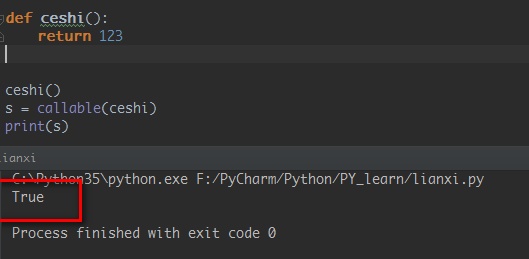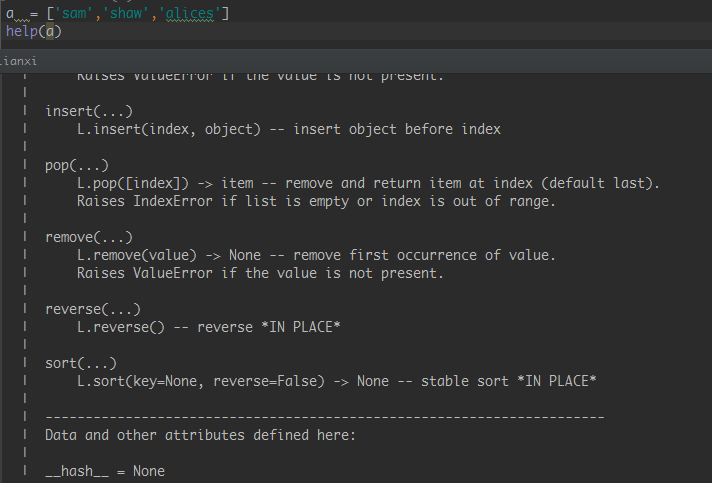Python内置函数总结
1、abs()
取绝对值
|
1
2
3
4
|
>>> a = abs(-7)>>> b= abs(7)>>>print(a,b)7 7 |
2、all()
循环参数,如果每个元素都为真,那么all的返回值为真
0,None,以及空值都为假,其他都为真(""为假," "为真)
|
1
2
3
4
|
>>> s = all([True,True])>>> f= all([True,True,False])>>>print(s,f)True False |
3、any()
循环参数,只要有一个为真,则为真
|
1
2
3
|
>>> f = any([True,True,False])>>>print(f)True |
4、ascii()
在给定对象的所属的类中执行该类的“__repr__”方法,获取其返回值

5、bin()
十进制转二进制
|
1
2
3
|
>>> s = bin(10)>>>print(s)0b1010 |
二进制转十进制
|
1
2
3
|
>>> i = int('0b11',base=2) # base=2表示二进制>>>print(i)3 |
6、oct()
十进制转八进制
|
1
2
3
|
>>> s = oct(8)>>>print(s)0o10 |
八进制转十进制
|
1
2
3
|
>>> s = int('0o11',base=8)>>>print(s)9 |
7、int()
十进制
8、hex()
十进制转十六进制
|
1
2
3
|
>>> s = hex(14)>>>print(s)0xe |
9、bool()
判断真假,把对象转换成布尔值
10、bytes() 字节
字符串转换成字节
|
1
2
3
|
>>> s = bytes('shaw',encoding='utf-8')>>>print(s)b'shaw' |
11、chr()
接收一个数字,查找数字对应的ascii表中对应的值
|
1
2
3
|
>>> shaw = chr(65)>>>print(shaw)A |
12、ord()
接收一个字符,查找该字符在ascii表中对应的数字
|
1
2
3
|
>>> f = ord('a')>>> print(f)97 |
13、callable()
检查对象是否可执行

14、dict()
把对象转换成字典
15、dir()
查看对象所有方法

16、divmod()
给定对象(除数,被除数),计算商与余数(计算结果为一个元祖类型)
|
1
2
3
|
>>> s = divmod(10,3)>>>print(s)(3, 1) |
17、enumerate()
对可循环对象前添加序号
|
1
2
3
4
5
6
7
8
|
>>>a = ['shaw','sam','alices',24]>>>for i in enumerate(a):... print(i)... (0,'shaw')(1,'sam')(2,'alices')(3,24) |
18、eval()
把字符类型转换成int,再计算结果
|
1
2
3
|
>>>s = eval('1 + 4')>>>print(s)5 |
19、exec()
用来执行python代码(表达式)
|
1
2
3
4
5
6
7
8
9
|
>>>exec('for i in range(8):print(i)')01234567 |
20、filter()过滤对象
filter('函数','可以迭代的对象')
# 循环对象中的每个元素,并作为函数的参数执行前面的函数,如果函数返回True,表示符合条件
|
1
2
3
4
5
6
7
8
9
10
11
|
def shaw(x): if x > 10: return Truea =[6,8,11,33,44]s =filter(shaw,a)fori in s: print(i)C:\Python35\python.exeF:/PyCharm/Python/PY_learn/lianxi.py113344 |
21、map()
map('函数','可以迭代的对象')
# 循环对象中的每个元素,并作为函数的参数执行函数,并返回新数值
|
1
2
3
4
5
6
7
8
9
10
|
def shaw(x): return x + 10a =[11,33,44]s =map(shaw,a)fori in s: print(i)C:\Python35\python.exeF:/PyCharm/Python/PY_learn/lianxi.py214354 |
22、format()
str格式化输出数据
|
1
2
3
4
5
6
7
|
a = ['sam','shaw','alices']fori in a: print('24{}'.format(i))C:\Python35\python.exeF:/PyCharm/Python/PY_learn/lianxi.py24sam24shaw24alices |
23、globals()
获取当前代码里面所有的全局变量
24、locals()
获取当前代码里面所有的局部变量
25、hash()
计算给定对象哈希值
|
1
2
|
>>>hash('shaw') 3346328168152020605 |
26、id()
查看对象的内存地址
|
1
2
3
|
>>>a = 123>>>id(a)1402863216 |
27、help()
查看对象所属类的方法的详细信息

28、input()
获取输入信息
|
1
2
3
4
5
|
user= input('用户名:').strip()print(user)C:\Python35\python.exeF:/PyCharm/Python/PY_learn/lianxi.py用户名:shawshaw |
29、isinstance()
判断对象所属的数据类型
|
1
2
3
4
5
|
>>>s = ['shaw','sam']>>>if isinstance(s,list):... print('haha')... haha |
30、len()
取对象的长度
|
1
2
3
|
>>>s = ['shaw','sam']>>>len(s)2 |
31、max()
取对象最大值
min()
最对象最小值
|
1
2
3
4
5
|
>>>f = [1,23,22,99]>>>max(f)99>>>min(f)1 |
32、pow()
计算幂
|
1
2
3
|
>>>i = pow(2,3)>>>print(i)8 |
34、round()
为对象四舍五入
|
1
2
3
4
5
6
|
>>>f = round(4.4)>>>print(f)4>>>f = round(4.6)>>>print(f)5 |
35、sum()
求和
|
1
2
3
|
>>>f = sum([11,22])>>>print(f)33 |
36、zip()
把两个可迭代对象,新组合成一个
|
1
2
3
4
5
6
7
8
9
|
s =[1,2,3]f =['a','b','c']k = zip(s,f)fori in k: print(i)C:\Python35\python.exeF:/PyCharm/Python/PY_learn/lianxi.py(1,'a')(2,'b')(3,'c') |
37、sorted()
排序
数字,按从小到大顺序排序
|
1
2
3
|
>>>f = [1,23,22,99]>>>sorted(f)[1,22, 23, 99] |
字符,先数字(从小到大),再字母(按字母在assic表中对应数字大小,从小到大),在中文
待完善。。。


【推荐】国内首个AI IDE,深度理解中文开发场景,立即下载体验Trae
【推荐】编程新体验,更懂你的AI,立即体验豆包MarsCode编程助手
【推荐】抖音旗下AI助手豆包,你的智能百科全书,全免费不限次数
【推荐】轻量又高性能的 SSH 工具 IShell:AI 加持,快人一步